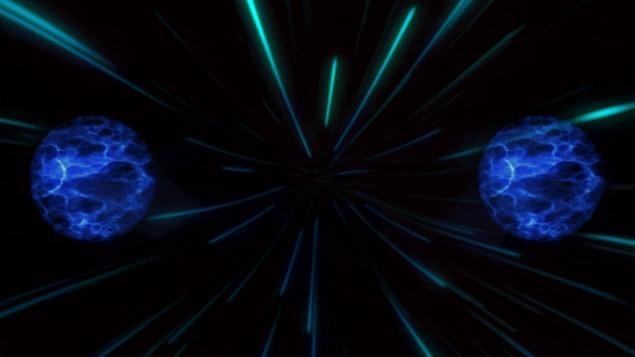A group of researchers has challenged the long-held belief that photons are unsplittable and that has changed how we perceive light. Photons are tiny particles that bear no charge and are massless. These are quantum of electromagnetic radiation that travel at the speed of light in a vacuum. Recently, a research team, comprising scientists from Dartmouth and SUNY Polytechnic Institute, has shed light on the existence of split photons. This finding is extremely important as it advances the fundamental understanding of light and its behavior.

Two halves: Artist’s impression of a photon that has been 'split' into halves. Image Credit: LaDarius Dennison/Dartmouth College
Topological photonics has recently attracted researchers considerably. Topological insulators possess many useful applications that include optical isolators and lasers. Particles exist in two different forms, namely, fermions and bosons.
Fermions (e.g., electrons) tend to live solitarily and avoid each other at any cost. Whereas, bosons (e.g., photons) have a tendency to cluster together. This is the reason why researchers presumed that splitting bosons could be a challenging task. In 2001, scientists proposed that electrons can be split into halves in certain superconductors. However, there is no evidence that demonstrates a similar phenomenon for photons.
What is Majorana Boson?
The theoretical discovery of split photons is referred to as Majorana boson. This concept has been published in Physical Review Letters, authored by Vincent Flynn and Lorenza Viola from Dartmouth College, and Emilio Cobanera from SUNY Polytechnic Institute. According to their calculations, Majorana bosons exist and it is a hypothetical quasiparticle that possesses many similarities with Majorana fermions.
This discovery is based on predictions made in 1937 by an Italian physicist named Ettore Majorana. He proposed the existence of neutral, electron-like particles known as Majorana fermions. He found that chargeless fermions could be described by a real wave equation, leading to the concept that this particle may be identical to its antiparticle.
Fermions and anti-fermions are indistinguishable and could co-exist without annihilating one another. Cobanera stated that the existence of Majorana fermions was the main driving force that motivated the team to conduct more research on the presence of unexposed Majorana boson.
Lights and Split Photons
Viola stated that their findings lead to a major paradigm change in the understanding of fundamentals and behavior of light. Researchers revealed that light can exist in different phases, where photons appear as two distinct halves. The change in phases of light is analogous to how liquid water can transform to solid ice or gaseous vapor. Viola explained that as in the case of water which can change its form depending on physical conditions, light must be regarded as matter that can exist in different phases.
Unlike pieces that can be simply pulled apart, photon halves are like different sides of a coin, i.e., two distinct halves make them whole; yet they are described as separate units with different functions.
According to Flynn, every photon can be conceptualized as a sum of two definite halves. In the new study, scientists have successfully discovered conditions for separating one half of a photon from another. This discovery has shed light on a previously unknown fact of light, i.e., the existence of a topological phase of light and matter which hosts Majorana bosons.
Instabilities were previously associated with the replication of the ground-state topology of a topological superconductor with photonics. However, in the new study, researchers revealed that this instability can be avoided if the system is made dissipative, as, in fermionic systems, energy dissipation can generate novel topological steady states.
In the new study, researchers calculated that Majorana bosons were unstable in zero-energy and non-propagating conditions. However, the mode became metastable when suitable energy dissipation was included in the calculation. Scientists also revealed that a larger system promoted the longer persistence of these states.
Scientists stated that further laboratory experiments are required to confirm the existence of the Majorana boson. Unlike the Higgs boson that requires an elaborate experimental setup, the Majorana boson could be easily determined via experiments supported by existing or near-term technologies.
Scientists observed that Majorana bosons could be experimentally identified via distinct signatures. Researchers have focused on verifying their predictions using photons in dissipative microwave cavities.
Our Understanding of Light
This theoretical invention of split photons or Majorana bosons has substantially advanced our understanding of light.
This study revealed that light must be regarded as a matter that can exist in various phases. Researchers stated that Majorana bosons could be a distant relative of Majorana fermions.
However, it is not yet clear how the findings could be applied, i.e., if they would be utilized for the development of new types of quantum information processors, light amplifiers, or optical sensors.
One of the most important aspects of this study is that it has uncovered a new phase of matter and light.
References and Further Reading
Flynn, P.V., Cobanera, E. and Viola, L. (2021) Topology by Dissipation: Majorana Bosons in Metastable Quadratic Markovian Dynamics. Physical Review Letters. 127 (24). DOI: 10.1103/PhysRevLett.127.245701
Majorana bosons could exist in dissipative systems, calculations suggest. (2022) [Online] Available at: https://physicsworld.com/a/majorana-bosons-could-exist-in-dissipative-systems-calculations-suggest/
Dartmouth College (2021) Discovery of ‘split’ photon provides a new way to see light. ScienceDaily. [Online] Available at: www.sciencedaily.com/releases/2021/12/211213111657.htm
Disclaimer: The views expressed here are those of the author expressed in their private capacity and do not necessarily represent the views of AZoM.com Limited T/A AZoNetwork the owner and operator of this website. This disclaimer forms part of the Terms and conditions of use of this website.